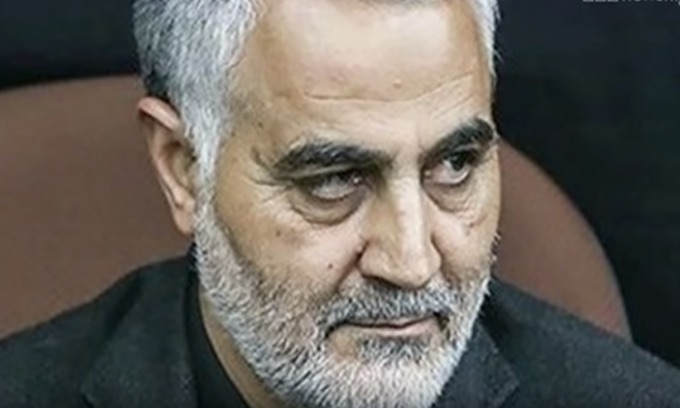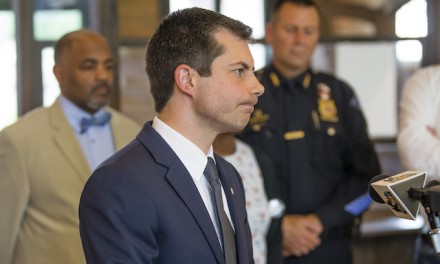Photographs of Iranian Maj. Gen. Qassem Soleimani surveying bomb-scarred Aleppo in September 2016 underscored how far the terrorist master was willing to go to extend Tehran’s iron hand across the Middle East.
The siege of the once-bustling industrial city and the isolation of 275,000 residents had intensified that month. Soleimani and his Quds Force, a U.S.-designated terrorist army, joined Iranian-financed militias and a smattering of Syrian soldiers and Russians in decimating the blocked-off, rebel-held neighborhoods.
Subsequent reports said Soleimani supplied a majority of the ground forces — 25,000. They herded and surrounded residents into Aleppo’s eastern sector, where Russian warplanes indiscriminately bombed civilian targets.
The next month, U.N. human rights chief Zeid Ra’ad al-Hussien condemned the “slaughterhouse” created by Syrian President Bashar Assad, Iran and Russia.
“The ancient city of Aleppo, a place of millennial civility and beauty, is today a slaughterhouse — a gruesome locus of pain and fear where the lifeless bodies of small children are trapped under streets of rubble and pregnant women deliberately bombed,” Mr. al-Hussein said, according to the BBC.
“Armed opposition groups continue to fire mortars and other projectiles into civilian neighborhoods of western Aleppo, but indiscriminate airstrikes across the eastern part of the city by government forces and their allies are responsible for the overwhelming majority of civilian casualties.”
Mr. al-Hussein accused Mr. Assad’s coalition, which included Soleimani, of grievous offenses.
“These violations constitute war crimes,” he said. “And if knowingly committed as part of a widespread or systematic attack directed against civilians, they constitute crimes against humanity.”
Reuters described the fighting: “Russian air power and Shi’ite militias from Iraq and Lebanon help the army recapture Ramousah on Sept. 8, firmly re-encircling the rebel enclave. On Sept. 22, the heaviest air strikes in months hit east Aleppo and the government announces a new offensive to retake it. … Many hospitals and other civilian infrastructure are hit.”
By December 2016, Aleppo had been mostly cleansed of rebels, some associated with Sunni terrorist groups, at a great civilian cost. Soleimani visited the city again, this time photographed amid the ashes of Aleppo.
President Obama singled out Russia, Syria and Iran: “The blood for these atrocities are on their hands.”
Tehran-born analyst Amir Toumaj said Mr. Assad could thank Soleimani and the Islamic Revolutionary Guard Corps’ Quds Force for his survival as Syria’s leader.
“After more than five years, Soleimani has succeeded in preventing the fall of Bashar al Assad, protecting Iran’s supply route to Lebanese Hezbollah, and laying siege to Aleppo, Syria’s largest urban area prior to the war,” Mr. Toumaj wrote in the Long War Journal, a blog-news site at the Foundation for Defense of Democracies. “He has mobilized thousands of Iranians, Syrians, Lebanese, Iraqis, Afghans, and Pakistanis to fight in Syria, forming an international Shiite expeditionary force.”
The White House said Soleimani was planning to apply the Syrian template in Iraq when President Trump ordered a Jan. 3 missile strike on his car near Baghdad International Airport. The direct hit killed the Quds Force commander and a traveling companion, Abu Mahdi al-Muhandis, leader of the Iraqi militia Kata’ib Hezbollah. He was a U.S.-designated terrorist and sent fighters to Syria.
On Dec. 27, Iranian-backed militia fighters launched missiles at a U.S.-occupied compound in Kirkuk, killing an American translator. Militias had launched at least 10 rockets at U.S. forces in the previous two months. The U.S. then conducted airstrikes on militia arms depots. On Dec. 31, Soleimani’s Iraqi supporters, including Kata’ib Hezbollah, besieged the U.S. Embassy.
Soleimani paid and armed about 100,000 Iran-loyal Shiite Iraqi militiamen. At his death, he was organizing a wave of missile strikes on U.S. troops, according to the Trump administration and some press reports.
Democrats accuse Mr. Trump of overreaching. They say the briefed intelligence does not show an imminent Soleimani-orchestrated attack.
Iran has not just lost a ground commander and strategist; it has lost a diplomat.
Soleimani first took control of Iranian operations in Syria after the 2011 uprising. As the civil war dragged on, he traveled to Moscow in the summer of 2015 and persuaded the Kremlin to enter the war. Two months later, Russia sent troops and warplanes to Syria and began airstrikes. Soleimani returned to Moscow two months after that for a war council with Russian President Vladimir Putin.
“He had a major diplomatic impact when he traveled to Moscow in 2015 to meet with Putin to encourage and coordinate with the Russian intervention later that year,” said Jim Phillips, a Middle East analyst at The Heritage Foundation.
In late December 2016, the Israeli Foreign Ministry issued a report on Soleimani in Syria, titled “Iran’s Pivotal Role in Aleppo Massacres.”
Soleimani was an enemy of Israel. He capitalized on his expanded adventure in Syria by placing militia fighters in bases closer to Israel, which Iran has vowed to destroy. Iran also funds another potent Israeli foe: Lebanese Hezbollah on Israel’s northern border. It too joined the Syrian war.
“Iranian-led troops have been responsible for mass executions, attacks on civilians, including on women and children, and for blocking civilian evacuation from the bombarded city,” the Israeli Foreign Ministry said. “Iran’s largest proxy, Hezbollah, which receives hundreds of millions of dollars in financial assistance from Iran, is deeply entrenched in the Syrian civil war, and was a key leader in the most recent ground assault in Aleppo.”
The People’s Mujahedeen of Iran (MEK), the main Iranian dissident group, also issued a report in December 2016.
“The fact is that Aleppo has been occupied by the IRGC and its mercenaries,” the MEK said. “Mass executions, preventing the transfer of the civilians, including women and children, [and] attacking the civilians has all been done by the forces of the mullahs’ regime.”
Soleimani, in effect, operated as a U.N. outlaw. The United Nations imposed a travel ban against him in 2007, which he routinely ignored, for trafficking illicit arms, including nuclear components.
Mr. Phillips said Soleimani’s death may produce what he sought. In a nonbinding vote, the majority Shiite members of the Iraqi parliament voted to expel U.S. forces.
“He may yet win a posthumous victory in Iraq if the political backlash against his death leads the Iraqi government to demand the withdrawal of U.S. troops, a long-term Iranian goal,” Mr. Phillips said.
© Copyright (c) 2020 News World Communications, Inc.
—-
This content is published through a licensing agreement with Acquire Media using its NewsEdge technology.



















Recent Comments